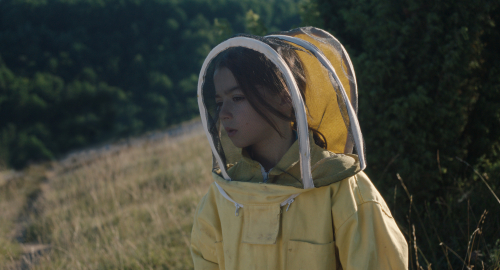
Gariza Films, Inicia Films
MOVIE REVIEW
20,000 Species of Bees (2023)
“20,000 Species of Bees” is about an 8-year-old child coming to the realization that they are not the gender assigned to them at birth, and whether or not the child’s family will be able to accept and adjust to this news. As the child, Sofía Otero, who is 8 herself, has just won the gender-neutral Silver Bear for Best Actor prize at this year’s Berlinale. This is an achievement on par with Quvenzhané Wallis’s Best Actress nomination for “Beasts of the Southern Wild” at the age of 6. But a film about a child whose gender identity is being questioned is such a hot-button topic that first-time writer/director Estibaliz Urresola Solaguren had 20,000 different ways to mess this up. It’s delightful to report that none of them happened.
They are a family of Basques living in Paris, who speak both Basque and Spanish at home: father Gorka (Martxelo Rubio), mother Ane (Patricia López Arnaiz) and three kids, teenage Nerea (Andere Garabieta), 10-year-old Eneko (Unax Hayden) and 8-year-old Aitor, also known as Cocó (Ms. Otero). Things are stressful at home; Ane and Gorka are on the verge of splitting up; and Cocó is unhappy all the time, acting out and generally being a pain. They’re a miserable bunch when Ane and the kids leave Gorka behind for a long stay with Ane’s mother, Lita (Itziar Lazkano), in a rural village in northern Spain. Lita is annoyed at Ane’s handling of her marital troubles and is further upset by Cocó’s long hair. Everyone keeps offering to lend Ane money which she keeps refusing. The local kids aren’t welcoming to the summer ones; and Cocó doesn’t want to go swimming in the pool. He much prefers hanging out with Lita’s sister, Lourdes (an outstanding Ane Gabarain, who gets to deliver one of the greatest pieces of dialogue in cinematic history), the village wisewoman who cures everyone’s aches and pains with her bees.
Ane’s late father was a sculptor of some renown, and in his old workshop she begins to make her own pieces for the first time in years. As Ane focuses on her work, Cocó begins to consider what’s going on with herself, and starts quietly asking the people around her questions about bodies, and how you know who you are. Lourdes notices that Cocó refers to herself using female words and pronouns, but Ane doesn’t notice that the reason Cocó doesn’t want to go swimming is that you need an identity card with your name on it, as well as to use a gender-specific changing room. Ane has been raising her children to believe there’s no such things as boys’ toys or women’s work, and doesn’t see the contradiction here. And it’s important to remember Cocó is 8; sullen silence and acting out are the main ways she can articulate her upset at being misgendered. The first time we see her smile is when some elderly neighbours look at her long hair and compliment Lita on her pretty granddaughter.
It's strongly implied Lourdes is a lesbian who has chosen to live a solitary life in the village rather than explore her sexuality elsewhere, but regardless she’s a welcoming influence for Cocó, giving her space to be herself away from the hectic, judgmental atmosphere at home. There’s also a summer girl who becomes Cocó’s first friend, and who needs literally nothing explained to her, since there’s a boy with a pussy at her school. The forthrightness about the human body here is startling to someone raised with American puritanicalism, but it’s generally just the normal experience of daily life with kids captured on film. Kids wet the bed and wash their hair and throw tantrums in shops and interrupt the adults while they’re in the shower; their little lives are revolved around the needs of their bodies and the resulting experiences are rarely shown on film in as raw and direct a way. The emphasis on the body’s requirements makes the point very clear – if you are not happy with the body you’re in, all these everyday experiences are painful instead of ordinary.
And there’s a fair amount of ordinary pain in this movie. The shot of the three siblings in unhappy silence in the car is a moving display of solidarity. Nerea makes a discovery about her grandfather which Ane downplays, but it’s clear the child isn’t truly aware of the repercussions of what she’s saying. Later Lita and Ane have a doozy of an argument, in which Ane scolds Lita for turning a blind eye to her father’s cheating, to which Lita retorts that if Ane truly wanted to be an artist she’d have stopped at one child. Ane’s happiness with her own work and getting to feel like herself again is a big contrast to Cocó’s misery – not least because the name Cocó isn’t right either; and the poor kid doesn’t know what is the right one. Gina Ferrer Garcia’s camera stays close to either Cocó or Ane, making sure we know the things they know, and consistently ensuring an intriguing balance between the summer sunshine and the village shadows.
This is not the first movie to address a child’s gender identity, but the French-Belgian film “Ma vie en rose” was more interested in ridiculing suburban conformity through how a town accepted a transgender child instead of the child’s acceptance of themself, and anyway 1997 was a long time ago. Ms. Urresola’s focus is on showing how a child learns to accept herself, and in so doing hope that her family and friends are able to do the same. It’s a lovely movie, which stands entirely on Ms. Otero’s small shoulders; and she carries it with a calm unusual in a child. Her acting prize was well deserved. And the title is a clue to how essential Lourdes’s bees are to the plot.
Comments